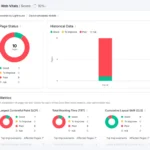
Introduction
In today’s crowded digital space, brands are competing for attention across social media, search engines, and email campaigns. Simply promoting products or services is no longer enough — audiences want stories they can relate to.
Storytelling in digital marketing is the art of weaving narratives that resonate emotionally, build trust, and drive engagement. Brands that master this craft don’t just attract customers — they create loyal advocates.
In this guide, we’ll explore how small and large businesses can use storytelling to connect emotionally with audiences, improve brand recall, and increase conversions in 2026.
1. Why Storytelling Matters in Digital Marketing
Digital marketing without storytelling is like a book without a plot — forgettable.
Here’s why storytelling is crucial:
- Emotional Engagement: Stories trigger empathy, curiosity, and excitement.
- Memorability: People remember stories far better than statistics or plain facts.
- Brand Personality: Narratives humanize your brand, making it relatable.
- Higher Conversions: Consumers are more likely to take action when they feel connected.
💡 Example: A fitness brand sharing a customer’s personal transformation story inspires new users more than simply listing gym packages.
2. Understand Your Audience Before Crafting Stories
Effective storytelling starts with knowing your audience. The more you understand their:
- Pain points
- Goals and aspirations
- Lifestyle and habits
…the better your story will resonate.
✅ Steps to Understand Your Audience:
- Conduct Surveys & Polls: Ask questions on Instagram, LinkedIn, or email campaigns.
- Analyze Social Media Engagement: See which posts evoke the most comments, shares, or likes.
- Monitor Competitor Strategies: Learn what works in your industry, then adapt it uniquely.
🎯 Tip: The deeper your audience insight, the more emotionally compelling your story can be.
3. Elements of a Compelling Brand Story
A strong digital marketing story should include these key elements:
- Relatable Characters: Represent your audience or customer personas.
- Conflict or Challenge: Show a problem your audience faces.
- Resolution: Demonstrate how your brand or product solves the problem.
- Emotion: Tap into feelings like hope, excitement, or empathy.
💡 Example: A skincare brand could showcase a real customer’s journey battling acne, highlighting challenges, solutions, and emotional transformation.
4. Platforms for Storytelling in Digital Marketing
Different platforms allow for different storytelling techniques:
| Platform | Storytelling Approach | Tips |
|---|---|---|
| Instagram & TikTok | Short, relatable, visual stories | Use reels, challenges, and behind-the-scenes clips |
| YouTube | Long-form video narratives | Tell customer journeys or tutorials |
| Blogs & Websites | Written, in-depth stories | Use storytelling frameworks like problem-solution-benefit |
| Email Marketing | Personalized, intimate stories | Include real testimonials or progress updates |
| Professional success stories | Share case studies, achievements, or industry insights |
🎯 Pro Tip: Repurpose your core story across multiple platforms in different formats to maximize reach.
5. Use Data to Make Your Stories More Impactful
Storytelling isn’t just about creativity — data ensures your story resonates and converts.
- Analyze which types of posts get the most engagement.
- Identify high-converting headlines and CTAs.
- Segment your audience based on behavior and craft stories that speak to each group.
💡 Example: If analytics show that posts highlighting sustainability get more shares, create stories around your eco-friendly initiatives.
6. Integrating SEO in Storytelling
Even the best story won’t perform if it’s not discoverable. Integrate SEO into your storytelling:
- Keyword Optimization: Include target keywords naturally in blog posts, video descriptions, or social captions.
- Meta Tags & Descriptions: Optimize titles and meta descriptions to attract clicks.
- Internal Linking: Link to other relevant content to keep visitors engaged longer.
- Structured Data: Use schema markup for FAQs, reviews, and articles to improve search visibility.
📊 Pro Tip: Storytelling + SEO = content that emotionally connects and ranks on Google.
7. Measure the Impact of Your Storytelling
To know if your storytelling strategy works, track these metrics:
- Engagement Metrics: Likes, shares, comments, and time spent on page.
- Conversion Metrics: Click-through rates, sign-ups, or purchases.
- Retention Metrics: Repeat visits, newsletter subscriptions, and returning customers.
💡 Tip: Adjust your stories based on performance — experiment with formats, length, and narrative tone.
Our Services SEO Services in Siwan | SEO Services in Azamgarh | SEO Services in Kolkata | SEO Services in Hajipur
FAQs: Storytelling in Digital Marketing
1. How often should brands share stories on social media?
Consistency matters more than frequency. Aim for at least 2–3 storytelling posts per week, mixing short-form (reels, posts) and long-form (blogs, videos) content.
2. Can storytelling help small businesses with a limited budget?
Yes! Authentic, creative stories often outperform expensive ads. Use customer experiences, behind-the-scenes content, and staff narratives to craft compelling stories without high costs.
3. How can data improve the effectiveness of storytelling?
Data reveals audience preferences, engagement patterns, and emotional triggers. By analyzing this data, you can tailor stories to increase shares, clicks, and conversions.
4. What is the difference between storytelling and traditional advertising?
Traditional ads focus on features or promotions, while storytelling focuses on emotions, experiences, and relatability. Stories naturally engage audiences, creating deeper connections and brand loyalty.
5. Can storytelling improve SEO performance?
Yes! Long-form, value-rich stories attract backlinks, keep visitors on your site longer, and naturally incorporate keywords — all of which boost search engine rankings.
6. Which brands are examples of excellent storytelling?
Some top examples include:
- Nike: Inspiring customer journeys and athlete stories.
- Airbnb: Stories of travelers experiencing unique stays.
- Coca-Cola: Emotional campaigns around happiness and togetherness.
Small businesses can emulate these principles on a local or niche level.
Conclusion
In 2026, digital marketing isn’t just about SEO or ads — it’s about creating an emotional bond with your audience. Storytelling allows brands to humanize their message, build trust, and drive conversions.
To succeed:
- Understand your audience deeply.
- Craft stories with relatable characters, conflict, and emotion.
- Use data and SEO to make your stories discoverable and impactful.
- Measure results and refine constantly.
✨ Remember: People don’t just buy products — they buy the stories, experiences, and emotions behind them.





